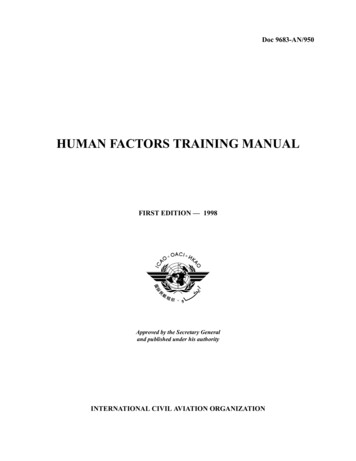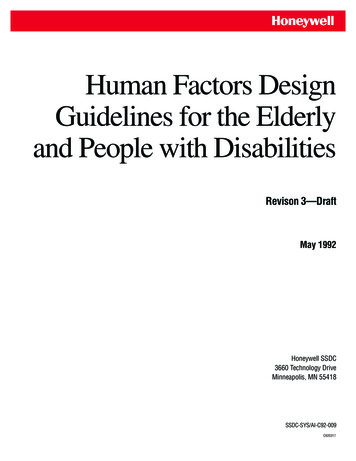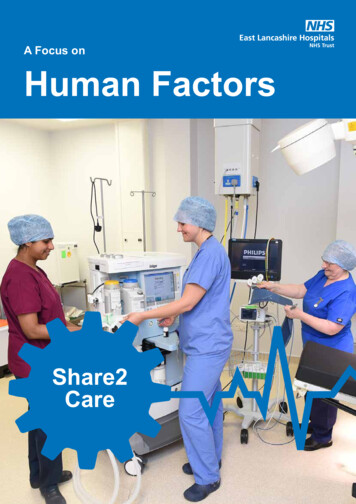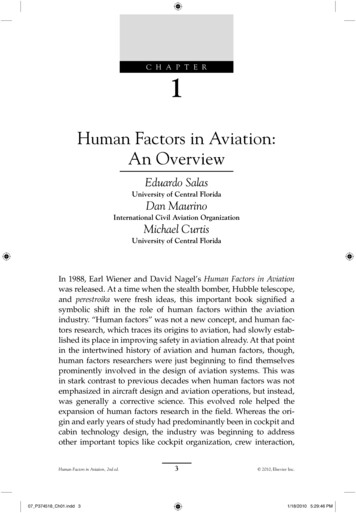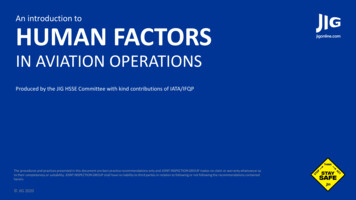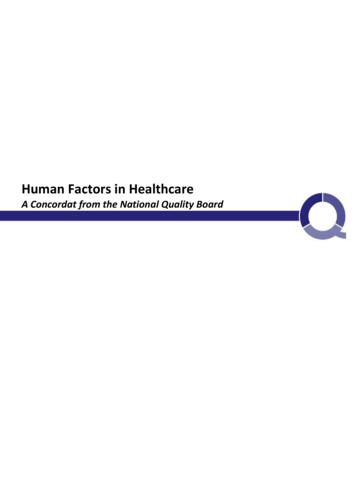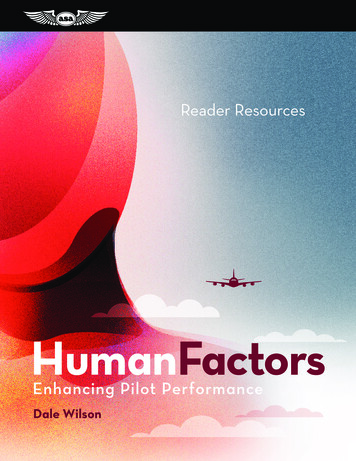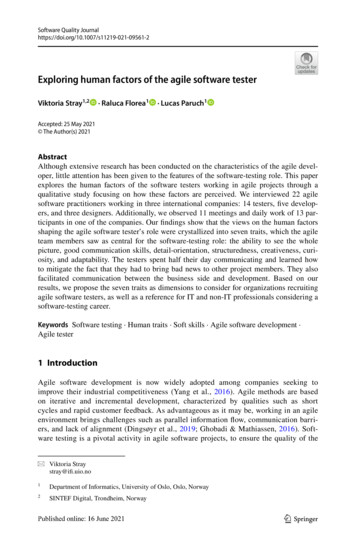
Transcription
Software Quality xploring human factors of the agile software testerViktoria Stray1,2· Raluca Florea1· Lucas Paruch1Accepted: 25 May 2021 The Author(s) 2021AbstractAlthough extensive research has been conducted on the characteristics of the agile developer, little attention has been given to the features of the software-testing role. This paperexplores the human factors of the software testers working in agile projects through aqualitative study focusing on how these factors are perceived. We interviewed 22 agilesoftware practitioners working in three international companies: 14 testers, five developers, and three designers. Additionally, we observed 11 meetings and daily work of 13 participants in one of the companies. Our findings show that the views on the human factorsshaping the agile software tester’s role were crystallized into seven traits, which the agileteam members saw as central for the software-testing role: the ability to see the wholepicture, good communication skills, detail-orientation, structuredness, creativeness, curiosity, and adaptability. The testers spent half their day communicating and learned howto mitigate the fact that they had to bring bad news to other project members. They alsofacilitated communication between the business side and development. Based on ourresults, we propose the seven traits as dimensions to consider for organizations recruitingagile software testers, as well as a reference for IT and non-IT professionals considering asoftware-testing career.Keywords Software testing · Human traits · Soft skills · Agile software development ·Agile tester1 IntroductionAgile software development is now widely adopted among companies seeking toimprove their industrial competitiveness (Yang et al., 2016). Agile methods are basedon iterative and incremental development, characterized by qualities such as shortcycles and rapid customer feedback. As advantageous as it may be, working in an agileenvironment brings challenges such as parallel information flow, communication barriers, and lack of alignment (Dingsøyr et al., 2019; Ghobadi & Mathiassen, 2016). Software testing is a pivotal activity in agile software projects, to ensure the quality of the* Viktoria Straystray@ifi.uio.no1Department of Informatics, University of Oslo, Oslo, Norway2SINTEF Digital, Trondheim, Norway13Vol.:(0123456789)
Software Quality Journalsoftware product throughout the iterative development process, with frequent releases(Korhonen, 2013).In agile, a noticeable divergence from traditional plan-driven development methodsentails involving testers from the beginning of each development increment. Therefore,dedicated testers can plan and complete various aspects of the test strategy, such asexploratory testing, usability testing, and improving test coverage with the developers(Bai et al., 2017; Santos et al., 2011). In such work environments, knowledge transfer also occurs more frequently and naturally between developers and testers, as bothtesting and development happen concurrently during each iteration. Even though testershad a difficult time finding their place in teams during the early phases of agile adoption, they quickly became integrated and recognized as an important part of agile software development (Cohn & Ford, 2003).The skills within development teams are crucial to the success of software projectsbecause they directly affect central aspects of software attributes such as performance,reliability, and simplicity (Byrd & Turner, 2001). There have been numerous studieson how team members’ skills affect the qualities of software as well as teamwork performance and the competitive market advantages those skills bring (Capretz & Ahmed,2010; Ebert & De Neve, 2001; Faraj & Sproull, 2000). Alternatively, as many researchers have shown, a lack of skills within development teams directly affects the costs ofsoftware projects, their delivery times, and even their completion (Jiang & Klein, 2000).In general, the literature presents testers with an emphasis on their hard skills—forinstance, as the ones responsible for carrying out testing and building up test cases andtest plans (Mathur & Malik, 2010). Davidov et al. (2010) described testers as professionals who identify new defects from failed test cases, analyze defects, and report themin a bug-tracking system. However, the testing process requires not only technical skillsbut also specific socio-technical abilities (Florea & Stray, 2018; Sánchez-Gordón et al.,2020); therefore, an efficient software tester is needed to cover a broad area of abilitiesand expertise, frequently extending beyond testing. For instance, in agile, software testers play a key role in connecting developers with development stakeholders and customers by intimately understanding and tracing business requirements throughout development (Saiedian & Dale, 2000). Nevertheless, there is a need for further studies focusingon agile testers’ soft skills (Sánchez-Gordón et al., 2020).In agile, attention has been given to developers’ skills from both industry (Capretz &Ahmed, 2010; Ebert & De Neve, 2001; Faraj & Sproull, 2000) and educational perspectives (Lethbridge, 2000; Lindstrom & Jeffries, 2004). However, the same cannot be saidabout the testers’ skills, as the role was largely considered a junior or entry position, andtesting seen as a side activity (Deak et al., 2013; Juristo et al., 2006).To better understand the agile software tester, we conducted an exploratory casestudy in three companies. The aim of this paper is to fill a research gap within the areaof software testing, focusing on the human dimension of the software-testing role.Although there has been extensive research on the technological aspects of softwaretesting—such as tool usage, test automation, and test processes—little research has beenconducted on the human factors central to the role of the software tester (Deak et al.,2016; Kanij et al., 2015). The current paper extends our preliminary findings on thehuman factors of the agile software tester from a single-case study involving 13 participants (Paruch et al., 2020a, 2020b).We aimed to answer the following research question: Which human factors are essential for the agile software tester?13
Software Quality JournalThe remainder of this paper is structured as follows. First, Sect. 2 presents the background and related work on the agile software tester. Section 3 reports on our case studymethodology. Section 4 presents the results of the study. Section 5 discusses the resultsand implications for practice as well as the threats to the study’s validity. Finally, Sect. 6concludes the paper.2 Background and related workIn this section, we first present the background of the agile software tester. Then, wepresent related work on human aspects of software testers through a literature review.2.1 Software testing in agileIn agile, a noticeable difference from sequential development methods entails involving testers at the beginning of each development iteration, instead of end-of-phase testing. One of the seven testing principles states that quality-assurance activities should bestarted as early as possible in the life cycle to avoid additional cost and time (ISTQB,2019). In agile, early involvement of testers at the start of the iteration enables anemphasis on the user stories and the system architecture, with which primary testingpersonnel will acquire a better understanding of the testing scope.Two studies focused on the differences between the test activities conducted in anagile project compared to a plan-driven project (Dhir & Kumar, 2019; Kettunen et al.,2010). Kettunen et al. (2010) performed a study on agile projects and identified theabsence of guidance on how testing should be arranged at the same time as development. Dhir and Kumar (2019) compared the testing of a Web application in a plandriven project versus in an agile project. Their results showed an improvement in theagile project compared to the traditional one: the agile project had increased test coverage, reduced costs, and improved testing productivity.Deak (2014a) identified and ranked testers’ motivation factors. The results showedthat the testers working in plan-driven projects experienced more stress but manifested amore positive attitude for tackling challenges than their agile counterparts did. The agiletesters were better integrated into their teams but expressed distress in their relationshipwith the developers, with whom they found it demanding to communicate.The delegation of testing tasks is also an essential feature of agile, as developers areexpected to perform unit tests independently. As such, testers can focus on test techniques such as exploratory testing and usability testing and improving the test coveragejointly with the developers (Bai et al., 2017; Santos et al., 2011).In agile, knowledge transfer also happens more frequently and naturally amongdevelopers and testers, as testing and development occur concurrently in each iteration(Li et al., 2010). While new team members benefit from the ongoing feedback in theironboarding, this competence sharing also contributes to less misunderstandings or confusion during development. The tight coupling among testers, developers, and stakeholders enables fast learning and greater mutual understanding.13
Software Quality Journal2.2 Related workAs we found limited research on the human factors of the agile software tester, we aimed toprovide an overview of the human factors in software testing, regardless of development methodology. The literature review was performed from September 2019 to December 2019, withthe main goal being to map the existing studies on the human factors in software testing andthe secondary goal of finding research gaps and needs for further studies. We looked to theliterature to answer the research question: Which human factors are essential for the softwaretester?2.2.1 Review methodThe search string presented in Table 1 was modified to fit the syntax of the different databases;however, the semantics were ensured to be consistent. We included the search term “qualityassurance” because some of the research papers use quality assurance instead of “softwaretesting,” and the two terms generally are interchangeable in the agile terminology. We followed Kitchenham and Charters’ (2007) suggestion to select search criteria meant to identifythe primary studies that provide direct evidence about our research question. In addition, wedecided on the criteria before the study selection to reduce the likelihood of bias.We devised the following protocols, which included both inclusion and exclusion criteria. In the inclusion criteria, we considered the relevant academic and industrial studies, bothqualitative and quantitative, as well as relevant conference papers, journal papers, workshoppapers, review articles, research articles, book chapters, and conference papers published inthe timeframe 2009–2019. We excluded from the analysis any non-English contributions,studies not related to software engineering, encyclopedias, prefaces, book reviews, casereports, correspondences, tutorials, editorials, and news reports.We obtained papers through four stages. The reviewing process was initiated by applyingthe search string to four scientific databases: Scopus, Science Direct, IEEE Xplore, and ACM(Stage 1). The application of the inclusion criteria and exclusion criteria and the removal ofduplicate studies resulted in 1160 papers, with most stemming from Scopus (956 papers). Allof the articles underwent a scrutinization phase where we inspected the title, abstract, and keywords for relevancy to our goal. We selected the relevant literature by removing studies without references to human factors and software testing. Most of the initial search results wereexcluded from further analysis, as they did not fit the general objectives of our research (Stage2) and belonged primarily to the medical and psychology fields. After skimming through the1160 papers, a total of 22 studies were included and read carefully. Seven of these papers didnot focus on the human factors within software testing and were excluded from further analysis (Stage 3). In Stage 4, we used the snowballing technique and found two additional articleson the human factors in software testing. As such, at the end of the selection process, we hadobtained 17 studies relevant to the research question.For the 17 selected papers, we extracted data manually and organized the information inan Excel spreadsheet. For each paper, we extracted the title, names of authors, publicationyear, source title, number of citations, and whether it was a conference or journal paper.Table 1 Search string for the literature review(“human factors” OR “soft skills”) AND13(“software testing” OR “quality assurance” OR “QA” OR“software quality assurance” OR “SQA”)
Software Quality JournalWhen reading the papers in detail, we highlighted passages and put relevant themes andcomments into the Excel sheet. By analyzing the objective of the papers, their results, andthe discussion of the findings, we found three themes emerging from the papers, and wegrouped the 17 papers by the theme they shared: (1) software testing as a profession, (2)motivational factors for software testers, and (3) the personal characteristics of softwaretesters. The grouping of the papers is shown in Fig. 1, and the findings in the three categories are presented next.2.2.2 Software testing as a professionResearch has been conducted before on software testing as a profession. Capretz et al.(2019) conducted a quantitative survey among professionals in four geographic regions todetermine the profession’s degree of attraction. Their results indicate that testing was not apopular career option among software professionals. Among the enumerated reasons werethe role’s perception as a lower-competence one and the testing job’s complexities resulting in stressful and frustrating situations. Shah and Harrold (2010) mentioned that seniortesters in a service-based software company located in India voiced similar opinions. Mostof the seniors had a negative attitude toward testing and considered it as something thatFig. 1 Three themes in the related literature13
Software Quality Journaljust needed to be done. The junior testers had a positive attitude toward the job, stating thattesting helped them to learn the system better so they could become skilled programmersin the future. The study found that all but one participant did not want to work permanentlyas a tester.Salman et al. (2019) conducted a controlled experiment to find out if testers exhibit confirmatory behavior—also known as positive testing—when designing functional test cases,and whether such behavior increased under time pressure. The findings resulted in the conclusion that confirmatory test cases were present regardless of time pressure; it is thereforenecessary to make testers aware of the danger of confirmation bias (the tendency to lookfor evidence that strengthens his/her prior beliefs) and learn how to design test cases with adisconfirmatory attitude (Salman et al., 2019).Ekwoge et al. (2017) identified three main categories affecting testers: cognition, conation, and affection. Cognition refers to memory, problem-solving, and decision-makingand how testers perceive the testing infrastructure. Conation includes impulse and desireand how testers see the value of their contribution. Affection involves elicited feelings andemotions, and influences testers’ respect, team belonging, and social factors. Deak (2014a)found that agile testers were more unhappy about their relationship with developers thantesters working in traditional plan-driven development. However, those testers in traditional development reported a higher degree of stress.2.2.3 Motivational factors for the software testersSantos et al. (2017) point out the importance of highlighting the testing activities as “a setof human-dependent tasks,” therefore emphasizing the need for research within motivation. They argue that five factors influence the motivation of software testers: acquisition ofuseful knowledge during work, work variety, creativity in solving tasks, well-defined workwith the precise sequence of steps, and recognition of work. The authors highlight the lastfactor, which has a lasting impact on the testers’ motivation as well as an increase in individual productivity and teamwork enhancement.Deak et al. (2016) also report similar motivational factors, such as enjoying challenges,variety of work, and recognition such as positive feedback received from both managementand developers. The authors also identified de-motivational factors, exemplified by timepressure, poor relationships with developers, lack of clear processes, redundant meetings,or lack of influence and recognition (Deak et al., 2016). Moreover, some of the participants in this study mentioned the tedious routine of some testing activities and the “feeling of boredom,” which would furthermore increase the assumption that the profession isunattractive.Hernández and Marsden (2014) investigated the challenges software testers face andhow they collaborate with other teams. Their findings showed that the testers were highlymotivated. They were motivated by the broad variety of topics they could work on and thatthey were able to have a complete view of the software. They were also intrinsically motivated when they experienced autonomy.Gonçalves et al. (2017) identified three main types of factors influencing the softwareprofession: cognitive, operational, and organizational. The cognitive aspects includedstress, psychological pressure, and retention of information under mental workload. Theoperational aspects included conflict, receptiveness, and monotony, whereas the organizational aspects included a lack of training, participation, and division of activities. The studyshowed that professional testers face many demotivational factors such as outdated testing13
Software Quality Journalenvironments, demobilization, and the devaluation of testing careers—which were oftenseen as a mere extension of development.2.2.4 Personal characteristics of the software testersKanij et al. (2014) found that human factors are crucial in software testing and that important traits for testers are being open-minded and having curiosity and “attention to details.”Kanij et al. (2015) argued that the effectiveness of a tester role was related to their personality and that testers had significantly higher levels of conscientiousness compared tothose in other software engineering roles. In the study, conscientiousness was related tobeing disciplined, hardworking, and dedicated. Although highly conscientious individuals were important in any profession, Kanij et al. (2015) suggested that this quality mightbe particularly important for testers. Deak (2014b) studied personal characteristics amongsoftware testing professionals and found that the most valuable characteristics to possessincluded communication skills, need for variety, and being detail oriented and curious.Livonen et al. (2010) explored the characteristics of high-performing testers, identifiedas such by a high defect-detection rate or by possessing traits that managers and other testers see as important. The authors found four themes: experience, ability to reflect, motivation, and personality. Within those themes, the top characteristics of the high-performingtesters were thoroughness, carefulness, patience, and conscientiousness (Livonen et al.,2010). Itkonen et al. (2013) investigated the knowledge types used by testers in exploratory testing and obtained three categories: domain knowledge, system knowledge (the actof knowing the system’s mechanisms, logic, and interactions), and generic software engineering knowledge (knowledge of the system’s usability and the ability to interpret errormessages).Two studies focused on the soft skills required by software testers. Matturro (2013) analyzed 43 recruitment advertisements to investigate the frequency of demand for soft skills.Among the most common soft skills for software testers were teamwork, proactive, analytical/problem-solving skills, and being methodic. Similarly, Florea and Stray (2018) analyzed 400 recruitment advertisements for software testers across 33 countries, following apre-existing skill taxonomy. The most frequently solicited traits were the ability to communicate both verbally and in writing, analytical and problem-solving skills, team spirit, andindependent-working skills.Cavin (2015) assessed the viability of military veterans in becoming software testers byinitiating a coursework program. Findings show that most veterans possess human factorsthat were aligned with the characteristics of a tester—such as communication, team player,and flexibility.3 Case study methodologyTo answer our research question, we conducted an exploratory multiple case study (Yin,2018) following the guidelines proposed by Runeson et al. (2012). The qualitative researchprocess included collecting data from a context-specific environment, analyzing the data,and interpreting the data.We collected the data through interviews and supplemented them with observations. Weinterviewed 22 practitioners in three companies. In addition, we observed 11 meetings and13
Software Quality Journal13 of our participants in their daily work. We attended eight daily stand-up meetings, twotest status meetings, and one domain-expert workshop.3.1 Case contextsCompany A is a medium-sized software-service-providing company with over 500employees in Norway, Denmark, Ukraine, and Slovakia. The company offers expertise inproject management, software testing, software development, interaction design, maintenance, and security. The organization consists of over 1000 employees in Scandinavia andhas focused, among other things, on automotive financing, sales financing, and loans. Theinterviewed professionals used agile methods and mainly Kanban development, combinedwith Scrum ceremonies. They used product backlog items extensively—usually in the formof a user story. Some of the interviewees had no time-boxed sprints, instead working witha continuous stream of tasks, as they appeared in the backlog. They were involved in prioritizing tasks and maintaining the product backlog. The testing professionals also participated in the test-automation processes. The team used mainly Slack, an instant communication tool that has 12 million active users daily (Novet, 2021). The tool allows written,verbal, and video communication and supports coordination and problem-solving in teams(Stray & Moe, 2020).Company B is a large-size supplier of software and services, mainly in the business,accounting, resource-planning, procurement, and retail areas, with over 9000 employeesin Scandinavia, Europe, and South America. All of the interviewed software practitionerswere members of agile teams, working distributed in two countries. These practitionerswere parts of different teams, yet their agile practices were rather similar. The teams had6–10 members and a team leader who acted as Scrum master. The product owners wereexternal to the team, which used 2-week sprints, with the product backlog as a central element in prioritizing and assigning tasks.Company C is a large financial services group provider whose main offices are located inNorway but with branches throughout the world and a medium-size software-developmentdepartment. The interviewed practitioners were parts of different teams, working in modified agile processes. The sprints spanned from weekly to monthly and could vary in length,depending on the potentially shippable product’s readiness.3.2 InterviewsWe conducted semi-structured interviews of 22 software professionals: 14 testers, fivedevelopers, and three interaction designers (see Table 2). We used purposeful sampling(Patton, 2014) to provide rich data on the factors perceived as central to the software-testerrole. The interviews were conducted between October 2019 and February 2020. A preliminary analysis of 13 of the interviews is reported in Paruch et al. (2020a, 2020b), and sevenof the interviews are partly analyzed in Florea and Stray (2020).All of the respondents (12 women, 10 men) consented to the recording of the interviewsand the printing of the results. Where necessary, we furthered our understanding of ourparticipants’ responses with follow-up questions and confirmed that we had captured theirresponses in entirety. We asked targeted open-ended questions, and we gave appropriatefeedback by encouraging our respondents to talk and by reflecting on their remarks. Simultaneously, the interviews were, to a great extent, protected from outside interruptions andfrom competing distractions.13
Software Quality JournalTable 2 Overview of the interviewsInformant no Current roleWork experience Interview method Interview lengthCompany A 1Software tester7 monthsFace-to-face53 min23456789101112Company B 13141516171819Company C 202122Software testerSoftware testerSoftware testerSoftware testerSoftware testerSoftware developerSoftware developerSoftware developerSoftware developerInteraction designerInteraction designerSoftware testerSoftware testerSoftware testerInteraction designerSoftware testerSoftware testerSoftware testerSoftware developerSoftware testerSoftware tester1 year4 years6 years3 years11 years1 year2.5 years2 years10 years1.5 years4 years19 years14 years21 years11 years35 years24 years11 years1 year17 years15 o-faceFace-to-faceVideocallVideocall1 h 3 min51 min1 h 6 min41 min30 min24 min20 min26 min38 min37 min41 min55 min1 h 5 min1h50 min1 h 8 min1 h 5 min55 min23 min1 h 10 min50 minWe employed semi-structured individual interviews because they allowed us to gaininsight into each participant’s views on the human software-tester factors, based on theirwork experience. An extract of the questions we asked the interviewees, separated into testing and non-testing positions, is presented in Table 3. The interview guide was slightlymodified as our research progressed. Appendix A shows how the full interview guide forthe software testers looked in our main data collection period. We held 15 face-to-faceinterviews and seven Skype video sessions. The shortest interview lasted 23 min, while thelongest lasted 1 h and 10 min; the average length was 52 min.3.3 ObservationsTo collect additional information for the study, such as the relative position of testers withreference to the other team members, as well as the attitude toward testers, we conductedobservations in one project taking place in a customer organization of Company A. Weobserved the project from November 2019 to January 2020. The meeting observationsincluded daily stand-up meetings, status meetings, and a workshop (see details in Table 4).During these meetings, we gathered information on the participants’ identities and theirrole within the team and company, the duration of the meeting, the topics discussed, andwho facilitated the meeting. Additionally, we took notes on the testers’ behavior during themeetings and our personal impressions of what was happening.13
Software Quality JournalTable 3 Extract of the interview guide used for the testing and non-testing positionsTesting roleNon-testing role Describe your role in the team, with typical tasksand assignments. Give me some examples of yourresponsibilities. What kind of testing do you like best? Why? When practicing your job, describe your knowledge in testing and beyond testing. What can you tell me with regard to your connection with the team (roles, team members)? Have there been challenges for your role relatedto testing? What traits should a good software tester have?Why? Are your skills measured and followed up atwork? How? How do you discover a significant bug? Are some testing skills more complicated toacquire? Who do you collaborate with the most? For howlong? Tell me about your role and assignments. Give mesome examples of test-related responsibilities youhad. How do you collaborate with software testers? Inwhich contexts? In what ways do you appreciate your collaborationwith the software testers? How would you describe your software-testing collaborators’ abilities? How would you describe a good tester? What abouta sub-optimal tester? Are any traits or skills more important for a testerto have? How do you feel that software testing is integratedinto the team’s practices?During the workday, we recorded the timestamp and description of the events relevantto our research, such as conversations between the testers and other team members, interactions between the testers, or calls for help involving testers. We also recorded informationon each team member’s current tasks. When observing casual and formal interactions during the workday, we followed the same procedure as above, noting the timestamp and theparticipants during the interaction. We aimed to note down as much details as possible.Additionally, we had access to all the participants in Company A on Slack, and couldobserve the participants communicating in an open Slack channel for the testers. Theobservation notes, together with Slack logs, were used to extract additional support for thedata collected through observations and interviews. For example, we observed what theparticipants discussed in the channel that could shed light on our findings and we also usedSlack for follow-up questions to the interviewees.Table 4 Overview of meetingsobserved13MeetingNumber ofparticipantsLength of meetingDaily stand-up78 minDaily stand-upDaily stand-upDai
conducted on the human factors central to the role of the software tester (Deak et al., 2016; Kanij et al., 2015). The current paper extends our preliminary ndings on the human factors of the agile software tester from a single-case study

